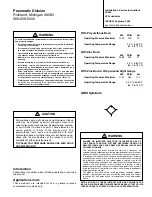
at 20 Hz and the
at 20 Hz. When configuring packet rates it is essential to ensure
the baud rate is capable of handling the data throughput. This can be calculated using the rate and packet size.
The packet size is calculated by adding the packet overhead to the packet length; the packet overhead is a fixed
value of 5. For example to output the system state packet at 50Hz the calculation would be:
Data throughput = (100 (packet length) + 5 (fixed packet overhead)) * 50 (rate)
Data throughput = 5250 bytes per second
Minimum baud rate = data throughput x 11 = 57750 Baud
Closest standard baud rate = 115200 Baud
When multiple packets are set to output at the same rate, the order the packets output is from lowest ID to
highest ID.
10.1.5 Packet Timing
Packets are output in order of packet ID from lowest ID to highest ID and all packets that are output in one
sequence have their data matched to the same time of validity. The time of validity can be found in either the
, the
or the
. For
example if the
,
and
packet
were all set to output at 10 Hz, at each 0.1 second period the three packets would output consecutively by order
of packet ID with all data synchronised between them and the
providing the time of
validity for the other two packets.
10.2 Data Types
The following data types are used in the packet protocol. All data types in the protocol are little endian byte
ordering.
Abbreviation
Bytes
Also known as
u8
1
unsigned char, unsigned byte, uint8_t
s8
1
char, byte, int8_t
u16
2
unsigned short, uint16_t
s16
2
short, int16_t
u32
4
unsigned int, unsigned long, uint32_t
s32
4
int, long, int32_t
u64
8
unsigned long long, uint64_t
s64
8
long long, int64_t
fp32
4
float
fp64
8
double
Table 28: Data Type Abbreviations used in the ANPP
v2.0
Page 75
04 Nov 2021
GNSS Compass Reference Manual • Advanced Navigation Packet Protocol
Summary of Contents for GNSS Compass
Page 1: ...GNSS Compass Reference Manual v2 0 04 Nov 2021 ...
Page 28: ......
















































